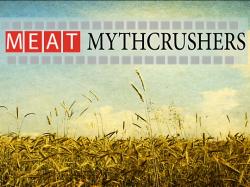New Meat MythCrushers Videos Address Misperceptions About Worker Safety & Line Speed In Meat Industry
March 28, 2016 | 2 min to read

Washington, D.C. —Two new videos in the Meat MythCrushers series take on long held myths about worker safety and how line speeds are regulated in the meat and poultry industry. The videos feature Dennis Burson, Ph.D. professor meat extension & food safety specialist at the University of Nebraska.
Dr. Burson discusses the improvements in the meat industry that have led to considerable worker safety benefits. Department of Labor statistics show meat and poultry industry injury and illness rates are at an all-time industry low of 5.5 cases per 100 full-time workers per year in 2014. The results demonstrate a substantial improvement from 10 years ago, when the number of injuries and illnesses stood at 10.3 cases per 100 full-time workers, and 20 years ago, when the rate was 24.3 cases per 100 workers.
“The industry took a very strong approach to worker safety as there are economic incentives to not have injuries in your workers,” Dr. Burson said. “Over the years there have been several things done to try to prevent injuries and illness in the workforce.”
Dr. Burson explains that one of the most significant drivers of worker safety improvement can be attributed to the creation of Voluntary Ergonomic Guidelines for the Meat Packing Industry developed in 1990 with the Occupational Safety and Health Administration (OSHA) and the United Food and Commercial Workers union. OSHA has called the guidelines a “model” for other industries.
The video also details the variety of tools workers use in meat and poultry plants to help ensure their safety.
In the second video, Dr. Burson clarifies how line speeds in meat plants are regulated, noting that USDA Food Safety and Inspection Service inspectors determine maximum line speeds and can slow down processing lines if there are food safety, worker safety or animal welfare concerns. He also clarifies that the speed of the line should be the focal point but rather how a line is staffed. A line can move more quickly when it is staffed more heavily, according to Burson.
The newest Meat MythCrusher videos are the 48th and 49th in the six year old series produced by the North American Meat Institute and American Meat Science Association featuring interviews with meat scientists who bust some of the most common myths surrounding meat and poultry production and processing. Altogether the videos have been viewed more than 130,000 times. Other video topics include myths surrounding meat nutrition, antibiotic use in livestock, “Superbugs” in meat, Meatless Monday, hormone use in animals, ammonia in ground beef, grass-fed beef and more.
All of the videos as well as a new brochure covering the different meat myths addressed in them are available at http://www.meatmythcrushers.com/.
Source: North American Meat Institute
